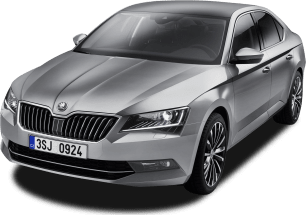The Superb wagon is an amazingly versatile car that's easy to live with. Its electric tailgate opens to reveal a cavernous luggage space; there is 660 litres behind the seats, which expands to 1960 litres when the seats are flipped down.
We love the handy seat releases near the rear door, along with shopping bag hooks, cargo cover, load restraint points, nets and a 12-volt socket. The load cover can interfere when larger bags or boxes are stowed, though, and the Skoda also sports an odd pseudo storage hammock that could easily be deleted.
Storage is plentiful, and there are two cupholders up front and another pair in the flip-down rear centre armrest – though the cupholders are frustratingly tiny in their diameter, defying even a regular can of drink.
Another four bottles can be stashed in the front and rear door pockets.
Rear seaters can also control the climate via temperature adjusters if they so desire. The SportLine even has heated rear outside seats, which also have ISOFIX child seat mounts added to them.
Up front is an inductive phone charging slot; simply place a suitable phone flat on the pad, and the car will charge the phone without a cable. Not only that, but the pad can enhance the signal of the phone. It didn't work with every phone we tried, though, and the slot is too small for huge devices like Apple's iPhone 6S.
If you're worried about ride height, don't be; the Superb cleared our steep drive test front and rear with ease.
The multimedia system has an 8.0-inch touchscreen and easy to use satellite navigation as well as Apple CarPlay and Android Auto. Phones are easy to connect and stay connected, too.
Seating is generous and supportive in all positions, with loads of room throughout the car for five people. Rear legroom is a particular standout, with our lanky teen enjoying limo-like space in the back seat.
The Alcantara fabric isn't perhaps as soft and as luxurious as the leather you'd find in the 206TSI 4x4, but it's grippy and comfortable, and cleans up just as easily as the leather, despite having perforations. Don't ask how we tested that...
And as usual, Skoda adds its cool little touches, with small umbrella ports in both front doors and garbage bins in the door pockets, as well as sun shades on the rear side windows.
Oh, and if you're worried about ride height, don't be; the Superb cleared our steep drive test front and rear with ease.






























